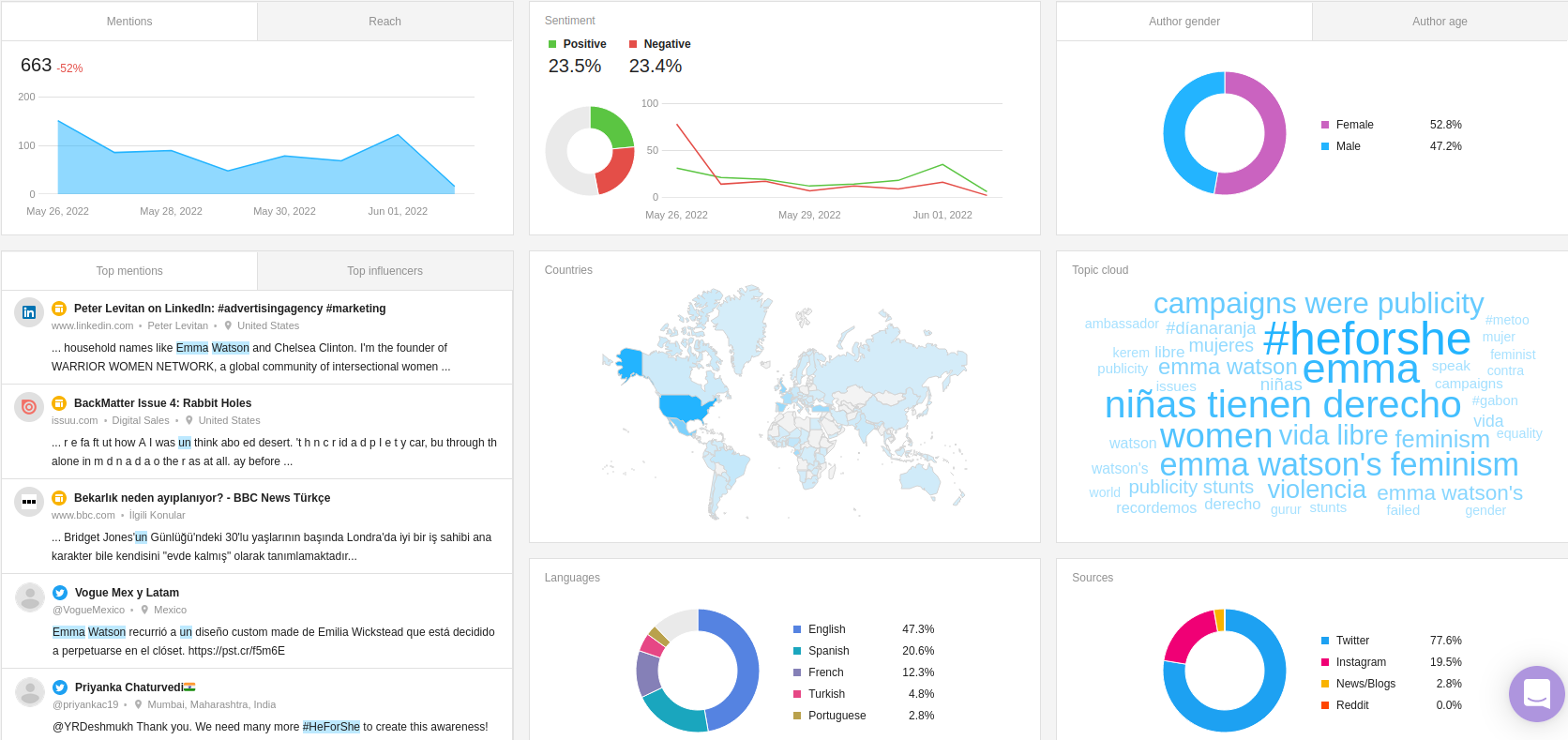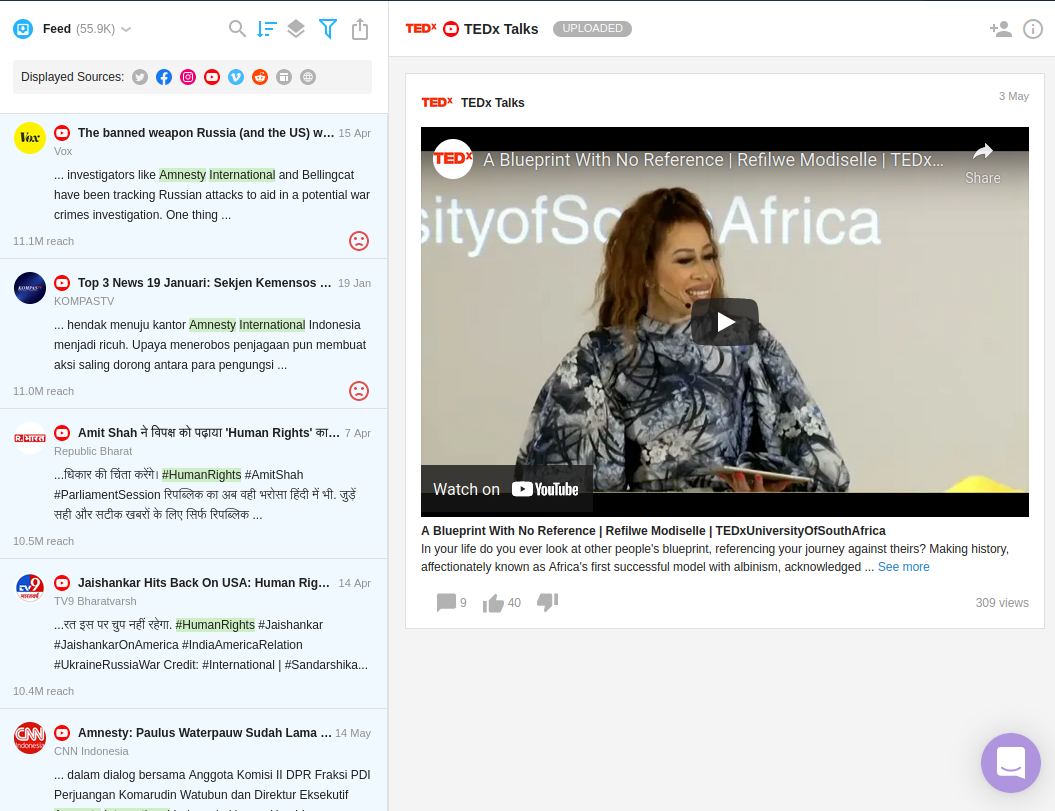Social media marketing for nonprofits: 10-step guide to reach your goals

Article summary
In this article, we explain how to create a social media marketing strategy from scratch for nonprofit organizations. We consider specific challenges nonprofits face and give you the tips and tools to overcome them.
15-minute read
- What is nonprofit social media marketing? How is it different from brand marketing?
- Step 1: Define your goals
- Step 2: Separate the campaigns according to the goals
- Step 3: Understand your audience
- Step 4: Choose the channels and study them
- Step 5: Pick the key message(s)
- Step 6: Create a social media policy
- Step 7: Create content that drives engagement and organic growth
- Step 8: Build community and integrate UGC content
- Step 9: Figure out your paid strategy
- Step 10: Analyze and perfect
We all hate the mythical figure of the "social media intern". You know, the idea that social media accounts of major companies and organizations are run by random people in their 20s who don't care about the organization

Truly, when people talk about social media marketing, It may feel like we all know how to run social media since we already use it in our personal life. So it's not really a job.
However, managing social media without any pre-thought won't bring you the results you need, even if those desired results are more followers and likes (which are not actual goals, we'll talk about goal setting later).
The truth is social media marketing is an intricate skill that requires mastering and refreshing like any other skill.
But let's admit it: nonprofits often suffer from a lack of resources and social media marketing is directly affected by that. Many organizations are likely to put their budget into more "serious" departments like fundraising and logistics, leaving social media to volunteers, or as a side task for a team member.
As a result, social media are often treated as an afterthought, a place to post announcements and occasional donation requests, and not as a major communication channel.
At the same time, the power of social media marketing is impressive. 29 percent of donors say a nonprofit’s social media presence inspires them to give even more than emails, websites, print, and TV ads.
This guide is for those who do social media marketing for their nonprofit and need no-fuss instructions on how to make it work in different circumstances: with limited budget, short deadlines, and urgent requests.
Whether you work at a local charity or an international organization, these steps will help you build the best social media marketing strategy for your nonprofit.
But before we take action, let's settle down on the terms we are using. What is social media marketing?
What is nonprofit social media marketing? How is it different from brand marketing?
To be honest, there is not much difference between nonprofit marketing and for-profit marketing. Essentially you're using social media to let people know about your organization and make them take some kind of action: either to buy something (in a brand's case) or donate, volunteer, sign a petition, etc.
The basic principles are also similar: you need to make the content and interact with people in such a way that they want to follow and engage with you. For that, you have to be aware of the latest social media trends and know your target audience well.
Now let's talk about the specifics that characterize nonprofit social media marketing.
-
As I already mentioned, nonprofit organizations typically have a smaller budget to allocate to social media marketing than brands. Moreover, they usually have smaller staff so the social media can be run by a marketing head, a PR specialist, or even a volunteer.
-
The goals are different. While you still might want to lead traffic to the website or raise awareness (not for a brand but for a cause), the end goal is not to sell something but make people donate, sign up for volunteering, encourage political or social engagementб and so on.
-
While stories are an important tool in any marketing campaign, nonprofit marketing tends to be even more story-driven. You are coming into a terrible situation and changing it for the better - that's a perfect story that can work wonders when it's shared with your audience.
-
Oftentimes, nonprofits have to talk about sensitive or upsetting subjects such as poor mental health, violence and abuse, and illnesses. You have to be very careful with crafting your social media message in order not to offend someone. Besides, some social media platforms, such as YouTube and Instagram tend to soft block and censor posts about sensitive issues, so if there's a story you need to tell, you have to consider the algorithms as well.
It seems like social media marketing is both easier and harder for nonprofits. Well, a proper social media marketing strategy can face up to any challenge and help you reach your actual goals.
Speaking of goals, they are exactly the first step to any marketing strategy.
Step 1: Define your social media marketing goals
The key to setting social media marketing goals is to understand why you are on social media. Not just because everyone is and, of course, every organization should have social media account in 2022. But what are you trying to accomplish by choosing social media as a communication channel with people?
More followers or higher social media engagement are not the social media marketing goals. These are metrics that can help you evaluate whether you're reaching your goals or not, and it's a good quantitative measurement of your successes, but they are not the actual reason you're on social media.
Social media marketing goals for nonprofits may look like this:
- Raise awareness around the cause you're advocating for and make people care about it
- Find beneficiaries for your organization
- Amplify fundraising and gather individual donations
- Attract volunteers
- Build a community of socially engaged activists
Of course, you can focus on several goals at once and add your own that are not on the list.
Once you define what you aim for, figure out how to evaluate these goals. What metrics will help you understand if you're going towards them or stuck in place.
These can be social media metrics, website traffic, and the number of donations and volunteers (but be sure to analyze if they came from social media).
At this stage, you can turn these one-line goals into SMART goals: specific, measurable, attainable, relevant, and time-based.
Step 2: Understand your audience
Now you know what you need to accomplish, it's time to figure out who you need to talk to accomplish these goals. It's time to do audience segmentation.
Intuitively, you might already know who your audience is.
After all, one of your audiences is your beneficiaries, and you already communicate with them through your service, so you understand what they need and how to reach them through social media. Unless you work in an environmental or animal welfare organization, trees and pandas don't use social media.
The second segment will be the general public who you need to "win over" i.e. make them interested in your cause and encourage them to take action. No matter what we want, these won't be just ALL the social media users - you need to understand what kind of people are likely to support your organization. For example, a young and hip New Yorker is unlikely to be interested in helping to organize Bible study groups in South Asia.
A great way to understand your audience is to create customer personas. Basically, you create a description of a person with their demographic characteristics, interests, views, and passions for each of your target audience. This helps you make your audience more real and understand them better.
By signing up I agree to the Terms of Use and Privacy Policy
Mind you, you don't just make up these descriptions. You need to run audience research either taking your existing supporters and analyzing their data or using social media.
We in Awario run audience researchers using our social listening tool. You can just put in the keywords related to your cause and see what people are talking about it and what they are saying.
For example, here's some data about social media users mentioning Amnesty International, a world-famous human rights organization.

We can see that social media users that are talking about the campaign mostly live in the USA, speak English and Spanish, are slightly more likely to be women, use Twitter and Instagram, and mention the campaign's ambassador, feminism, and violence against women.
All of this information we got just from analyzing one hashtag! Imagine how much you could gather from a proper social media listening research of your cause.
If you want to try Awario for audience research, we offer a 7-day free trial and a 50% discount for nonprofit organizations.
Step 3: Separate the social media campaigns according to the audiences
At this stage, you need to understand what content your different audiences will want to see. Some types of content will be interesting for everyone, while others cater to specific audience segments you created.
For example, the people who need your services are not interested in the content that explains the basics of your cause and why it's important. However, they'll be happy to know about your work, what you accomplished, what programs and projects you're running, and so on. This information will also be useful for potential donors and volunteers.
In addition to that, you can have regular and one-off campaigns centered around specific events:
- A campaign dedicated to a specific date (for example, World Earth Day)
- A campaign for urgent organizing to gather support in an emergency situation
- A campaign dedicated to a specific program or project
Separating these campaigns will help you understand what kind of content to create and what social media policies you need to establish. Besides, in case of a crisis situation or a need for an urgent campaign, you'll already have a game plan.
Step 4: Choose the channels and study them
Here's a social media marketing truth that perhaps will bring you relief: you don't have to be everywhere. You don't have to start an account on every social media platform. You don't even have to be on the Big Four (Facebook, Instagram, Twitter, and recently, TikTok). You just have to be where your audience is.
As I already mentioned, audience analysis shows you where your audience hangs out the most.

For example, Awario showed us that the #HeForShe conversations are happening on Twitter and Instagram, so these would be the platforms to choose if you are targeting this audience.
For now, Awario doesn't monitor TikTok mentions, so you would have to check this platform manually - just search for the hashtags and keywords related to your cause and see how many videos are there and what kind of engagement they get.
In this case, talking to your existing audiences to find the platforms they use may not be enough: you might neglect some part of your audience by focusing only on one segment and one platform. That's why I hardly suggest you try social listening for audience research.
Once you choose two or three platforms, research them vigorously. Study the trends, popular content, the algorithms of the platforms, and the influencers. Make sure you understand your audience and the exact way they use these platforms.
Nonprofit marketing tip
TikTok, Instagram, Facebook, and perhaps other social media platforms enable you to add donation buttons and stickers to your account and stickers. Don't ignore this feature! It may become a source of constant donations that is not tied to any campaign and works just because of your general social media presence.
Step 5: Pick the key message(s)
The term is pretty self-explanatory - key messages encompass the information you want your audiences to hear, remember, and share about your nonprofit organization. Basically, it's your mission statement and organization description in one.
Obviously, different audiences will need different interpretations of your key message to communicate.
For example, let's say you run social media for an animal shelter. Here's how you can create a key message depending on your target audience segment.
Key message: We protect the welfare of animals in our community through education, adoption and fostering, and animal advocacy.
-
For adoption customers/constituents: By adopting or fostering, or by alerting us of animals in need, you can help us protect the welfare of animals in our community.
-
For volunteers: We protect the welfare of animals through round-the-clock animal care and advocacy.
-
For donors: You can help us protect the welfare of animals by donating to support animal care, advocacy, and adoption promotion.
All of these key messages have the same purpose and undertone, but they vary slightly depending on your audience. Together with your nonprofit organization's mission, vision, and goals, these messages will help effectively communicate and market your organization's needs and purpose.
Step 6: Create a social media policy
Social media policy helps you avoid PR scandals and makes it easier for anyone on your team to help you with social media marketing (or to take over when you're on a break/sick leave). For nonprofit organizations it's vital to have a detailed social media policy for two reasons:
- Social media marketing is often done by volunteers who can come and go, so in order to be consistent, you need to have comprehensive guidelines.
- Sensitive subjects require care and attention to language, which many people, especially those who are new to your cause may not have yet. By highlighting them in your social media policy, you avoid public mistakes and potential reputation damage.
You can change your policy based on the activity on social, your overall marketing strategy, and the size of your organization, but here are the points a typical social media policy includes:
-
The language you use when talking about your cause, beneficiaries, sensitive issues
-
Your policy on responding to comments
-
How to handle conflicts on social media
-
How you handle data and privacy
-
A directory of team members, roles, and contact information
-
A crisis communications plan
-
Guidance on how staff and volunteers should behave on their own accounts
Step 7: Create a content calendar that drives engagement and organic growth
We finally arrived at the part where you post something! In my opinion, creating content is the most creative but also most demanding part of social media marketing. In order to avoid a creative block, you need to have a content calendar or editorial in place.
We already wrote a comprehensive guide on building a social media editorial, so I suggest you read that article. Here I'll just give some tips specific to nonprofit organizations that lack resources, both in budget and in hours.

It's likely you have only one person managing social media, and perhaps they even have other obligations on top of that. Considering these, I suggest you divide the content you create into two groups: low-cost and high-cost assets.
A low-cost asset is any social media post that doesn't require much time to create.
This of course will depend on your skills - if you are a Canva pro, an infographic will be a low-cost asset for you, while for us who are less talented designers it will be a high-cost one.
The point is that you can create this kind of content in bulk or on the fly. Yous still need to plan it out thoroughly with the help of your editor, but it will require fewer resources.
High-cost assets are those which production requires more time, skills, perhaps the expertise and participation of other people - these can be videos, interviews, podcasts, influencer posts and so on. These posts should be worth it i.e. you expect them to perform extremely well.
How to predict that? Use social media analytics, both native and social listening to understand what content gets the most shares and engagement.
For example, you can use Awario to find the social media posts with the highest number of impressions in your niche and analyze what they have in common.

All in all, you can create fewer high-cost assets but make sure they are evergreen (meaning they will always be relevant) and impactful.
Remember, that storytelling and emotions are the goldmine when it comes to social media marketing for nonprofits. Think about what story each of your posts tells and how it contributes to your overall narrative.
By signing up I agree to the Terms of Use and Privacy Policy
You can also plan out the hashtags you're going to use.
If you find yourself stuck creatively, check out this article on social media ideas for nonprofits for some inspiration!
There are many tools that can help you with content creation and offer free plans or discounts to nonprofits. Check out this list of marketing tools for nonprofits to learn more.
Step 8: Build community and integrate UGC content
Curate content from volunteers, customers, supporters, event attendees, and donors. Implementing a user-generated content (UGC) campaign not only lessens your workload but also acts as strong social proof. To enact your UGC campaign, put out a call for constituent stories, images, and videos. Create a hashtag that people can use to alert you of the new UGC.
Here's an Instagram post referencing an animal shelter form one of their clients - the shelter could benefit from sharing it to their Stories or even make a post with all the adoptees and how they changed after finding a new family.

Also, let curation tools work for you. Awario alerts you when your organization, hashtags, or relevant topics or keywords are mentioned. This provides opportunities to source UGC, get inspiration for new topic ideas, and participate in relevant conversations.
Step 9: Figure out your paid strategy
Social media marketing isn’t just about you or your team posting compelling content to build a following – known as organic content. There are also ways to extend your reach further and target specific audiences by using paid social media advertising.
But is paid advertising suitable for your nonprofit? It depends. The rules for paid social media advertising are constantly evolving, with important implications for nonprofits.
The best platforms for paid advertising currently are Instagram, Facebook, and YouTube, however, they may not accept certain ads based on the subject matter or limit their reach. Check the platform's rules carefully before you decide to invest in paid advertising on it.
Step 10: Analyze and perfect
The final step in any strategy is always the evaluation of it.
Remember the metrics we discussed in Step 1? The ones that help you analyze your performance?
Look at them regularly (weekly, monthly) and check in with your goals. Here's what metrics and assets will generally help you if your strategy is successful:
- The engagement rate
- The number of followers
- The number and the sentiment of comments
- The social media awareness and sentiment around your organization (can be calculated with Awario or other social listening tools)
- The most successful posts
- The least successful posts
- The website/newsletter traffic
- The donations coming from social media
This short list should be enough for a basic evaluation of your social media strategy and, of course, you should update it depending on your organization's goals and needs.
In conclusion
Ten steps may seem like a lot but they actually make social media marketing for nonprofits fairly simple.
We want to help you change the world so in addition to a 50% discount on our tool we regularly publish resources for nonprofits on our blog. Subscribe to learn more about nonprofit marketing with Awario!













